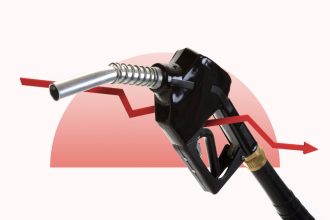Key Takeaways
- With a couple of personal documents handy, you can easily open a checking account online.
- Look beyond promotional offers to check for monthly maintenance fees, ATM charges and overdraft fees.
- After opening an account, set up direct deposits, automate bill payments and monitor your balance to avoid overdrafts. Keep only what you need in checking and transfer extra funds toa high-yield savings account.
A checking account is a place where your money can constantly move in and out.
Checking accounts aren’t all the same, however. Some are free, while others charge fees, and some are designed specifically for certain types of people including seniors, students and anyone who has struggled with money management in the past.
If you’re just beginning to budget and build the financial foundation for your life, read on to learn more about what a checking account can do for you and how you can open one without going to a bank branch.
How to open a checking account, step-by-step
Opening a checking account online is a relatively painless process with one caveat: You are a U.S. citizen. If you’re a non-U.S. citizen, you may still be able to open a checking account, but be prepared for some extra work and the potential need to make an in-person visit.
If you have your Social Security Number close by, here’s what you need to do:
1. Research checking account options.
There are more than 4,000 banks and more than 4,000 credit unions in the country, which means you have a lot of options for find a checking account. As you begin comparing different accounts, make sure that any financial institution on your list is insured by the Federal Deposit Insurance Corp., or FDIC (for banks), or the National Credit Union Administration, or NCUA (for credit unions), to safeguard your deposit against the unlikely occurrence of an institutional failure.
Bankrate has a host of tools to help you compare checking accounts, including an annual percentage yield calculator that can help you track how much interest you could earn over time.
Once you check that box, consider how each account option fits your financial lifestyle. Do you deal with cash on a regular basis? Find out whether the bank has ATMs located nearby. Do you plan to use your debit card for everyday spending? Be sure to focus your search on rewards checking accounts that can pay you back for your activities. Will you be doing the majority of your banking digitally? Look at other customers’ reviews of the mobile app experience.
2. Review the terms and conditions.
In addition to the bold details that look attractive – a $200 bonus for new customers, for example – dig into the fine print of each account to understand the fee structure and minimum balance requirements. In Bankrate’s recent Checking Fee Study, 32 percent of adults are paying monthly fees for their checking accounts, and those expenses add up to a sizable chunk of money.
3. Submit your application.
You can’t just automatically open a checking account. Instead, the bank needs to approve your application. Be prepared to provide personal details, including your address, past addresses, phone number, birthdate, occupation and other personal information. You can do this at a branch or online.
What do you need to open a checking account online?
You can make a lot of major financial moves with some cash and a Wi-Fi connection, such as buying a car or a house. And, when you need to take care of smaller monetary decisions, the majority of those activities can also happen from the comfort of your couch, including opening a checking account.
Here’s what you’ll need.
1. Confirm your identity.
When you’re applying for a new checking account, make sure you have a copy of your government-issued ID, such as your driver’s license, as your bank may ask you to scan a photo. Additionally, have your mobile phone nearby, as many banks will send you a text to verify it’s really you attempting to open the account.
2. Make your first deposit.
While many banks don’t have minimum deposit requirements to open a checking account, you’re going to need to have money in it to be able to use it. The easiest and fastest way to fund your account is with an ACH transfer of funds from another account. However, if you don’t have another bank account, it’s okay. You may be able to snap a photo of a check and make a mobile deposit. Depositing cash at an ATM may be available, but if you’re opening a checking account at an online-only bank, this might not be an option.
How much should you keep in your checking account?
How much money you should keep in your checking account is highly dependent on your particular financial situation. You’ll need enough money in your account to pay for ongoing expenses, including subscriptions, but you also don’t want it to languish there when you could be earning interest through a high-yield savings account. If you follow the zero-based budgeting method, every dollar of your income will be allocated to some bucket, including expenditures and savings, so that your income minus expenditures equal zero at the end of the budgeting period.
3. Arrange deposits and payments.
Once you have your account number and routing number, you can set up your checking account to do what it’s meant to do: Accept money and pay your bills. Ask your employer to begin making direct deposits into the account, and consider setting up auto-pay for your fixed expenses to make sure that your payments always arrive on time.
4. Activate your debit card.
Your bank will send you a physical debit card in the mail, which typically takes around 10 business days to arrive. When it shows up in your mailbox, look for instructions on how to activate it. In some cases, you may be able to just use it for an in-store purchase, while others may require calling a phone number and entering your PIN.
Checking account fees you need to know about (and can avoid)
Banks charge a wide range of fees for checking accounts, but there are easy ways to make sure you don’t ever pay them. Here’s a rundown of the most common fees attached to checking accounts – and how to work around them:
Monthly service fees: Many banks charge monthly service or monthly maintenance fees. However, you can avoid this cost by satisfying certain conditions, such as maintaining a certain minimum balance. If you’re worried about keeping your balance high enough, just look for free checking accounts that don’t come with any additional strings attached.
ATM fees: According to Bankrate’s latest Checking Account and ATM fee study, banks charge an average of $4.77 for withdrawing cash from an ATM that isn’t in their network, and that isn’t the only cost you may incur for the withdrawal. The owner of the machine may also impose a fee. Some online-only banks will pay you back for out-of-network ATM fees, although the reimbursements may be capped at a maximum dollar amount per month.
Overdraft and non-sufficient funds fees: Overdraft and non-sufficient funds (NSF) fees represent a huge slice of the banking industry’s pie: Consumers paid more than $5.8 billion in these fees in 2023 , according to the Consumer Financial Protection Bureau.
Look for a bank that has reduced or eliminated overdraft fees, or you can stay hyper-focused on monitoring your balance. Set up account alerts for automatic notifications if your checking account drops below a certain threshold.
Bottom line
For most people, opening a checking account online only takes a few minutes. However, you should invest more of your time before applying for an account to make sure you choose a bank or credit union that meets your unique needs. Some banks will charge you a fee if you wind up closing the account too early, so do the work to find a financial home that will be able to serve you for the foreseeable future.
Read the full article here














